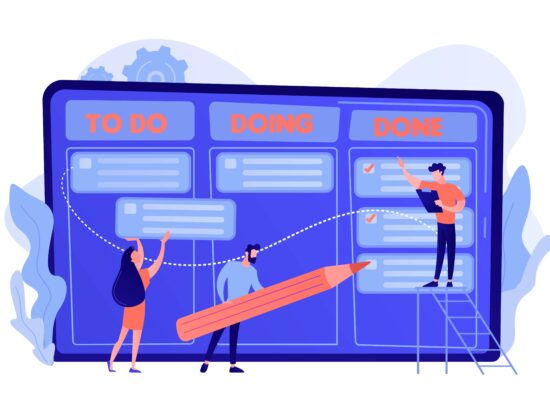
Stop starting, start finishing!

Delivering work in a quick and efficient way could be a challenge. The Kanban Method suggests an approach of managing the workflow with an emphasis on continuous improvement without overburdening the development team that focuses on productivity and efficiency.
The Kanban method is a “pull” system, that is to say that work is pulled into the system when the team has capacity for it, rather than tasks being assigned from the top. It can help both agile and DevOps teams establish order in their daily work.
In a Kanban process, there are virtual or physical “cards” called Kanban that move through the process from start to finish. It is the project portfolio of the organization, of the team, represented in a visual way, which will align everyone, communicate equally and directly to all, push to govern, to improve.
For me, the important characteristics of Kanban are that it optimizes workflow and musters your team’s full capacity. At the end of the day, it increases the overall level of customer satisfaction. This is due to the integration of a “pull” approach which means that work is started only when there is a real demand for it.
Kanban does not require that much effort; it can be very structuring for the organization and can bring a lot of value.
In this article, we will discuss what the Kanban Method is, how to implement it, and what the most important principles are.
Where to start?
Start with what you are doing now. Simply put all the projects the organization is working on on the board, virtual or not. It may look very silly. Just display the projects everyone is working on. You take a morning to gather all this information. You have it already? Good for you. So now every project or product conversation is about something that’s on the wall, right?

So rather than displaying a shapeless pile quickly give a dynamic reading and encourage creation by simply introducing the process steps (from left to right): backlog, to do (all the tasks that have not yet started), in progress (the tasks that have started), done (completed tasks).
But backlog, to do, in progress, done soon becomes too succinct. And not very representative of reality, which is what matters to us. For this reason, we might as well go and ask everyone about the project or product flow and place the right steps. Therefore it is very important to remember this first essential rule: Show the reality and nothing but the reality. To all the questions that you ask yourself when carrying out a Kanban, this is the most relevant answer: state realities. If the Kanban shows realities, no one will refuse the discussion.
Visualize workflow

The first and most important task is to understand the current flow of work – what is the sequence of steps to execute in order to move an item from request to a deliverable product. This is done using a Kanban board with cards and columns: each column represents a step in your workflow, and each card represents a work item. Every item moves through the flow from start to end. By observing this process, you can easily track progress and identify bottlenecks in real-time.
How many elements?
I could observe that a Kanban includes at least twenty elements (just an empirical measure), otherwise, the elements will not have enough dynamics. And therefore will not give enough sense of progress for you to feel involved. It is probably time to think about a finer breakdown of the elements: but again, only if it corresponds to realities. If you change something on the Kanban you should immediately change it into reality (so rather one thing at a time…). If you have less than 20 or 30 items and the slow evolution of the Kanban is demotivating you, it is probably just a reflection of what is happening in reality; things aren’t moving forward fast enough, you’re probably working on too many big blocks.
Clear rules
People won’t feel motivated to be part of something unless they think it will be useful. To facilitate involvement and initiative, it is important to have clear rules. Clear rules allow everyone to be involved in the best possible way. In Kanban we often specify, but only if it is the reality, or if we decide that it becomes the reality, we often specify who owns the column, who is responsible for it, who can manipulate its elements. Each person can suggest ways to improve your performance.
Similarly, it is often valuable to specify the output criteria from one column to another. Adding and clarifying exit criteria often happens when a record goes into a column, then back to the previous one, or even several times.
However, be careful to keep the reading of your Kanban simple. It is this compact, synthetic aspect that makes it easier for everyone to connect to a central, shared element. It is the vision by theme that best helps to make decisions.

Global view
You have a global vision that allows you to see where you are working, what are the densities, what are the voids, what are the balances between your different domains. At a glance you will be able to see the dynamics, the inertia, the anticipations, the densities, the gaps, the voids, the overflows, the choices, the outstanding, etc.
By observing and analyzing flow efficiency, you can identify any problem areas. The main goal of implementing Kanban is to create a smooth workflow by improving the lead times and avoiding delays. You should always strive to make your process more efficient.
The limits
Stop starting, start finishing! This is a Kanban adage. By constraining the flow at certain points, we force ourselves to have a more rhythmic flow, and this often promotes inter-column synergies.
Kanban projects have Work In Progress (WIP) limits which are the measure of capacity that keeps the development team focused on only a small amount of work at one time. It is only when tasks are completed that new tasks are pulled into the cycle.
WIP limits indicate the maximum number of elements allowed per column or block or horizontal line depending on the way you work (or all at once). A column with a WIP limit of three cannot have more than three cards in it. Proper WIP limits will ensure your team is never overburdened yet always has something to do.
Limits will push us to finish and to finish faster we will cut our value creation into smaller elements.
This approach enables management to reprioritize work back to the moment it was started. It’s an effective way to remain adaptive to market changes since you’re always working on what’s most important first.
How to calculate the limits? Vast debate. First, experience Kanban a bit. Observe and when you see it fit, place the limits in a way that is consistent with what you have discovered; they must impact realities.
The emergencies
When we talk about “limits” we quickly come to talk about “emergencies”. It’s hard to tell a customer ‘Sorry, but the service has reached its limits and we won’t be able to meet your request’.
In short, despite the limits, it is often relevant to have a horizontal line dedicated to emergencies. Emergencies whose number we will limit ourselves. If everything is an emergency, there is no emergency.
The moments of synchronization
For a positive change to occur, regular meetings are necessary to provide essential feedback to the entire team. The frequency of these meetings varies, but the idea is to make them regular, at a fixed time, and to get straight to the point.
There are several moments of synchronization. Probably a weekly or daily synchronization point in keeping with the Scrum method: here is where the focus is, here is the key element this week, here is the most important action, etc. I recommend about 30 minutes. Finally, a monthly improvement point in retrospect like the Scrum retrospective, this is a time to change the organization, look for ways to improve things, propagate learnings, etc.
Lead time
Kanban lead time is the time between a request being made and a task being released. It’s the total time the client is waiting for a task to be delivered. Lead time is frequently used by Kanban teams to evaluate customer satisfaction.
Kanban cycle time is calculating the actual work-in-progress time. It tracks how long a task stays in the different process stages. Keeping cycle times down keeps lead time down and usually fast lead times mean higher customer satisfaction.
So, the key to keeping Kanban cycle time down is setting a deadline on your work in progress.
Tools for getting started with the Kanban method

While some businesses prefer to use physical whiteboard-and-stickies Kanban boards, the majority use online solutions. There are a lot of Kanban tools on the market, as well as project management platforms suitable for its implementation. Some of the simplest and most flexible ones are Trello, Monday, Kanbanize, Asana, Jira, and Azure DevOps, ideal for building Kanban boards and managing projects.
Kanban approach helps maximize customer satisfaction
The “pull” approach makes sure that you design and build projects based on actual demand and not forecasts.
As a project manager, you need to find a way to eradicate any excessive waste from your process. That’s why your team shouldn’t be working on tasks that are currently not in demand or don’t create enough added value for your customer.
An example is the code review column that you can place on a Kanban board after every specific activity. With its help, you will not just signal that something is ready to move downstream but also make sure that any mistakes that might have been accumulated in the work process, are cleared.
By allowing your team to focus on just the right tasks and keeping your priorities in order, stalled or half-finished tasks are not likely to pile up.
As a result, you will make sure that the final product that reaches your customer’s hands is suitabled and therefore fit your customer’s needs. The benefit of this will be that your clients will be satisfied with what you have delivered to them. Try it and see!


